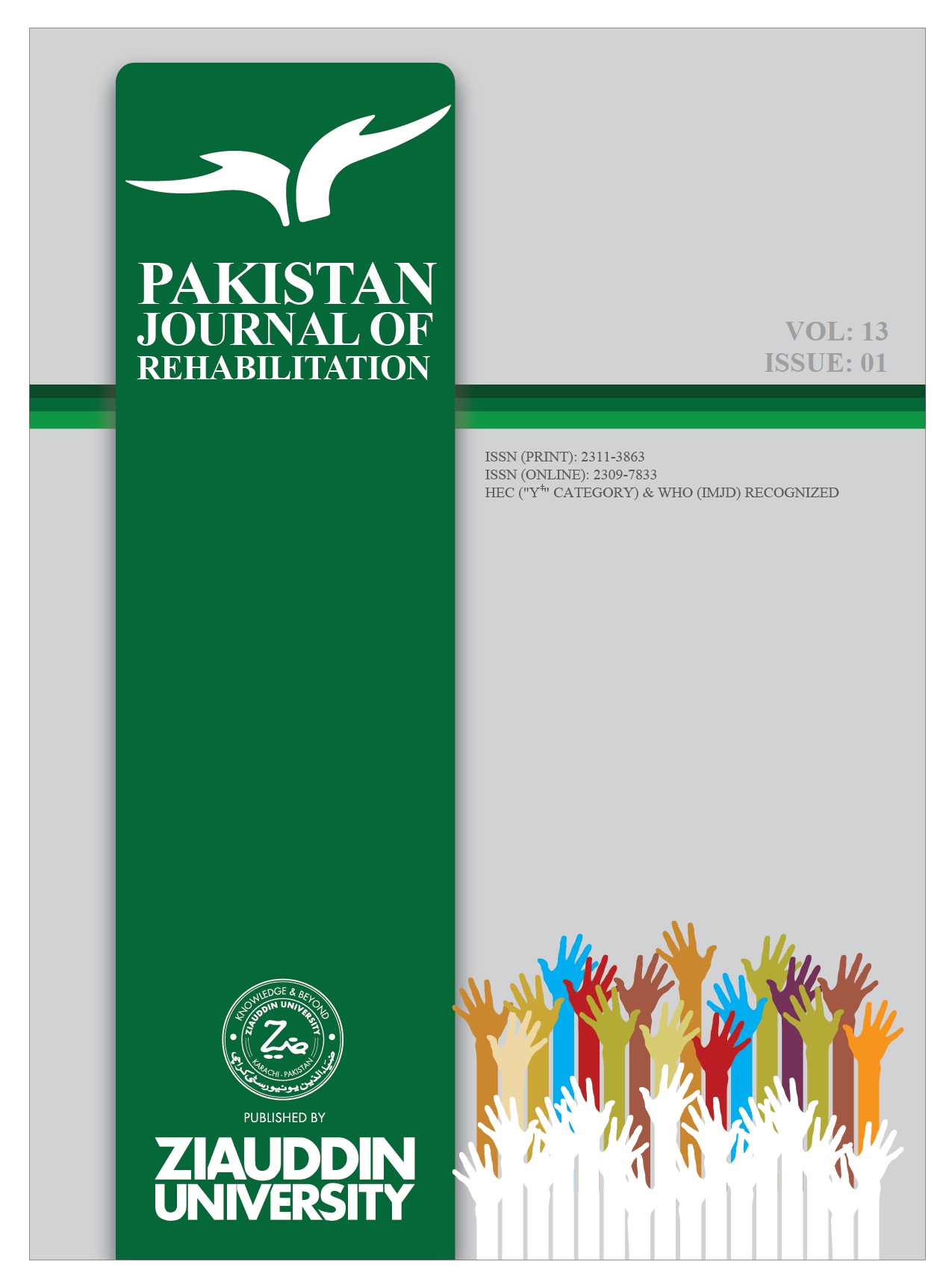SMART FOOT INSOLE FOR REDUCING THE RISK OF FOOT ULCERS IN DIABETIC PATIENTS BY MEASURING PLANTAR PRESSURE
Keywords:
Blood glucose, type 1 diabetes mellitus, flat foot, metatarsal, foot orthosis, diabetic neuropathy, foot ulcers.Abstract
Background of the Study: The prevailing cause of Diabetes is a decline in insulin production, the outcome of which is an elevated glucose level in the blood. The superabundance of glucose in the blood can cause severe complications, damaging other body organs, including kidneys, nerves, heart, and upper and lower limbs. However, the common complication in diabetic patients is foot ulcer, which is directly associated with Diabetic peripheral neuropathy (DPN), which is the extensive cause of this. DPN is the inability of nerves to sense any external change, due to which the foot plantar pressure is altered and evolves because of the high glucose level.
Methodology: This paper provides a solution in the form of a portable and cost-effective device based on force sensors for diabetic patients to monitor the change in foot plantar pressure at home and overcome the risk of foot ulceration. The device is implemented on 30 participants to characterize the plantar pressure values with flat foot and normal foot types for the Control group and diabetic group.
Results: An evident difference in the value of Mid-foot pressure is observed for both the groups, Control group (Normal foot = 144+2.63 kPa, Flat foot = 150+2.72 kPa) and Diabetic Group (Normal foot = 213+2 kPa, Flat foot = 216+1 kPa). Deviation in these values discriminates the mid-foot pressure for the two groups, thus providing us a range for the individuals of the control group for the alarming situation.
Conclusion: Noticing the plantar pressure through the proposed device helps diabetes patients reduce their risk.
References
Svoboda Z, Janura M, Kralova L, Vareka I. The influence of foot type on pressure distribution during gait. Gait & Posture. 2014;39:S67
Taha Z, Norman M, Omar S, Suwarganda E. A Finite Element Analysis of a Human Foot Model to Simulate Neutral Standing on Ground. Procedia Engineering. 2016;147:240-245.
Bacarin T, Sacco I, Hennig E. Plantar Pressure Distribution Patterns During Gait in Diabetic Neuropathy Patients with a History of Foot Ulcers. Clinics. 2009;64(2):113-120.
Jarrett L. Prevention and management of neuropathic diabetic foot ulcers. Nursing Standard. 2013;28(7):55-65.
Boulton A, Kirsner R, Vileikyte L. Neuropathic Diabetic Foot Ulcers. New England Journal of Medicine. 2004;351(1):48-55.
Bondar A, Popa A, Papanas N, Popoviciu M, Vesa C, Sabau M et al. Diabetic neuropathy: A narrative review of risk factors, classification, screening and current pathogenic treatment options (Review). Experimental and Therapeutic Medicine. 2021;22(1):1-9.
Buldt A, Murley G, Butterworth P, Levinger P, Menz H, Landorf K. The relationship between foot type and lower limb kinematics during walking: a systematic review. Journal of Foot and Ankle Research. 2012;5(S1).
Gawronska K, Lorkowski J. Evaluating the Symmetry in Plantar Pressure Distribution under the Toes during Standing in a Postural Pedobarographic Examination. Symmetry. 2021;13(8):1476.
Ko M, Hughes L, Lewis H. Walking speed and peak plantar pressure distribution during barefoot walking in persons with diabetes. Physiotherapy Research International. 2011;17(1):29-35.
Gravante G, Russo G, Pomara F, Ridola C. Comparison of ground reaction forces between obese and control young adults during quiet standing on a baropodometric platform. Clinical Biomechanics. 2003;18(8):780-782.
Baris R, Narin S, Elvan A, Erduran M. FRI0638-HPR Investigating Plantar Pressure during Walking in Plantar Fasciitis. Annals of the Rheumatic Diseases. 2016;75(Suppl 2):1284.3-1285.
Periyasamy R, Anand S. The effect of foot arch on plantar pressure distribution during standing. Journal of Medical Engineering & Technology. 2013;37(5):342-347.
Economic costs of diabetes in the U.S. in 2012. Diabetes Care. 2013;36(4):1033–46.
Duan Y, Ren W, Liu W, Li J, Pu F, Jan Y. Relationship Between Plantar Tissue Hardness and Plantar Pressure Distributions in People With Diabetic Peripheral Neuropathy. Frontiers in Bioengineering and Biotechnology. 2022;10.
Ahmad N, Thomas GN, Gill P, Torella F. The prevalence of major lower limb amputation in the diabetic and non-diabetic population of England 2003–2013. Diabetes and Vascular Disease Research. 2016;13(5):348–53.
Van Schie C, Boulton A. Biomechanics of the Diabetic Foot. The Diabetic Foot. 2006;185-200.
Abri H, Aalaa M, Sanjari M, Amini M, Mohajeri-Tehrani M, Larijani B. Plantar pressure distribution in diverse stages of diabetic neuropathy. Journal of Diabetes & Metabolic Disorders. 2019;18(1):33-39.
Hsiao H, Guan J, Weatherly M. Accuracy and precision of two in-shoe pressure measurement systems. Ergonomics. 2002;45(8):537-555
Bagherzadeh Cham M, Mohseni-Bandpei M, Bahramizadeh M, Kalbasi S, Biglarian A. The effects of vibro-medical insole on sensation and plantar pressure distribution in diabetic patients with mild-to-moderate peripheral neuropathy. Clinical Biomechanics. 2018;59:34-39.
Yu X, Yu G, Chen Y, Liu X. The Characteristics and Clinical Significance of Plantar Pressure Distribution in Patients with Diabetic Toe Deformity: A Dynamic Plantar Pressure Analysis. Journal of International Medical Research. 2011;39(6):2352-2359.
Ko M, Hughes L, Lewis H. Walking speed and peak plantar pressure distribution during barefoot walking in persons with diabetes. Physiotherapy Research International. 2011;17(1):29-35.
Paiva Magalhães E. Foot Pain, Function and Plantar Pressure Distribution in Rheumatoid Patients Wearing Insoles an Observational Study. Biomedical Journal of Scientific & Technical Research. 2018;2(2).
Deschamps K, Matricali G, Roosen P, Desloovere K, Bruyninckx H, Spaepen P et al. Classification of Forefoot Plantar Pressure Distribution in Persons with Diabetes: A Novel Perspective for the Mechanical Management of Diabetic Foot?.PLoS ONE. 2013;8(11):e79924.
Armstrong DG, Boulton AJM, Bus SA. Diabetic foot ulcers and their recurrence. New England Journal of Medicine. 2017;376(24):2367–75.
ZHI X, WANG W, XU B, ZHOU J. Effectiveness of Pressure-Relieving Shoes/Insoles on Lowering the Plantar Pressure of Diabetic Foot: A Meta-Analysis. Leather and Footwear Journal. 2020;20(4):361-374.
Chow T, Chen Y, Hsu C. Relationships between Plantar Pressure Distribution and Rearfoot Alignment in the Taiwanese College Athletes with Plantar Fasciopathy during Static Standing and Walking. International Journal of Environmental Research and Public Health. 2021;18(24):12942.

Additional Files
Published
How to Cite
Issue
Section
License
Copyright (c) 2024 Pakistan Journal of Rehabilitation

This work is licensed under a Creative Commons Attribution 4.0 International License.



